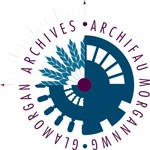The photographs featured this week are of St John the Evangelist Church at Penllyn. However, when the photographs were taken it was known simply as the Penllyn Chapel of Ease – in essence, a chapel built within the boundaries of a parish for the convenience of those not able to travel easily to the main church.

The chapel is thought to date back to the seventeenth century. By the 1840s, however, it had fallen into disrepair and was described as in a …very unprotected state with …the exterior semblance of a white washed barn. Initial repairs to the boundary walls began on 25 January 1842 to mark the christening of the Prince of Wales. Newspaper reports, however, suggested that the work was soon overtaken by the celebrations with …long life and happiness to the Royal Infant …drunk amidst enthusiastic cheers and firing of guns by the villagers and neighbours collected upon the spot.
The chapel was eventually saved and renovated by John Homfray, who bought Penllyn Castle in 1846. At its reopening, on 13 January 1850, the chapel was praised as having been transformed into a handsome gothic structure with …windows of beautiful stained glass… and …an altar of polished stone. Homfray also laid out the grounds around the chapel with shrubs and evergreens to complement the ornamental gardens at Penllyn Castle.

Renovation of the chapel was one element of a significant programme financed by Homfray that included the construction of the lodge seen in the second photograph, and described as “Tudorbethan” in style. It no doubt suited Homfray and the locals to avoid what was described as …a most inconvenient journey… to the church at Llanfrynach, particularly in the winter months. Major services and funerals, however, would still have been conducted at St Brynach’s. As a result, the paths across the fields, between the chapel and Llanfrynach, had three stone piers at each field boundary so that coffins could be rested while the party crossed the stile.
In dating the photographs, we are fortunate in that the People’s Collection Wales has a postcard version of the picture of the Church and the Lodge. It is thought to have been sent by a member of the Homfray family to a relative in Australia around 1910. The two photographs are, therefore, almost certainly early examples of Edwin Miles’ work and date from 1901 to 1910.
The photographs of Penllyn Chapel and Penllyn Chapel and Lodge can be found at Glamorgan Archives under references D261/M402 and M410. We plan to feature more photographs from the Edwin Miles collection over the coming months. The main collection can be seen at Glamorgan Archives or online in the catalogue at http://calmview.cardiff.gov.uk/ under reference D261. The postcard held in the People’s Collection Wales can be seen by searching for “Edwin Miles” at www.peoplescollection.wales.
Tony Peters, Glamorgan Archives Volunteer



